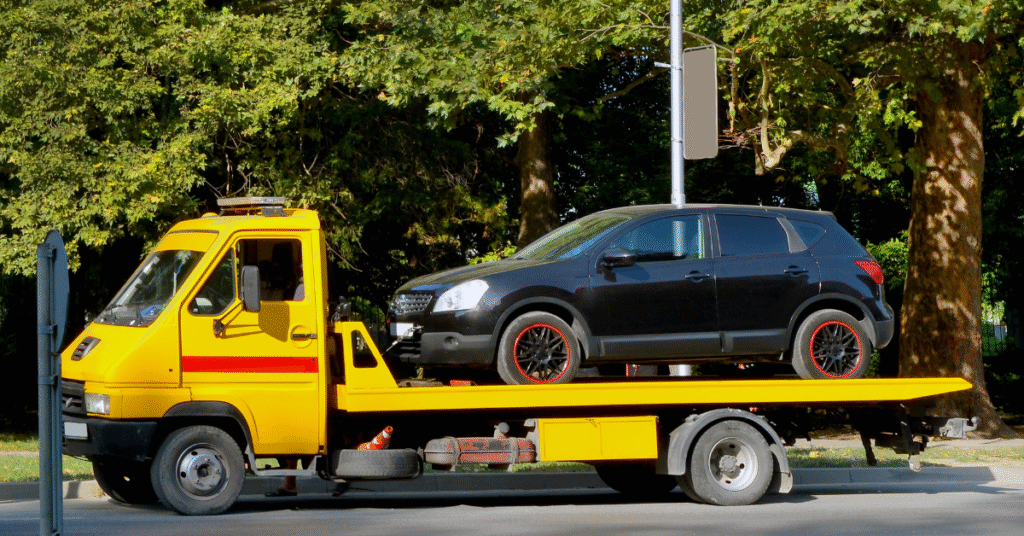Flat towing… dolly towing… These are two popular choices among car owners and RV enthusiasts. But what if we told you there are differences between them? Confused? Don’t worry, you’re definitely not the only one. Both approaches indeed differ in how they work and what they cost. In fact, they also support specific vehicles.
So what are those differences really? In this blog, Brisbane Towing & Recovery – trusted experts in vehicle towing and roadside assistance in Brisbane – will deliver a comprehensible towing comparison that portrays the distinctions between flat towing and dolly towing.
Let’s find out which makes more sense for your car!
What Is Flat Towing?
Flat towing, also known as four-down towing, is a method of towing a vehicle that is still on the ground, meaning its four wheels are intact and it can be driven. A tow bar is used to connect the car that is being towed to the towing vehicle, while special base plates are installed on both cars.
This option is quite common among RV owners when they want to take their small cars with them during the journey, but do not want to use a heavy trailer.
What are the Benefits of Flat Towing?
This approach comes with several key advantages:
Quick Setup
After the tow bar and base plate have been installed, the time for the vehicle to be connected or disconnected is only a few minutes.
Space Saving
By the fact that there is no dolly or trailer, flat towing can be stored in a smaller space, and getting parking spaces becomes more convenient.
Smooth Ride
If all four wheels remain on the ground, the towed vehicle is driven almost manually, offering better stability on highways.
Lightweight Setup
Flat towing minimally adds to the weight of the towing vehicle, thereby allowing easy maneuverability and lower fuel consumption.
What are Drawbacks of Flat Towing?
Before moving to our next contender a.k.a. dolly towing, it makes sense to talk drawbacks of flat towing:
Limited Vehicle Compatibility
A lot of cars cannot be flat towed due to incompatibility. Only a handful of automatic and electric vehicles. Trying forcefully to flat tow an incompatible vehicle can cause severe transmission or drivetrain damage. Potentially leading costly repairs.
Initial Setup Cost
The base plate installation in your car, along with a brake system and a tow bar, is the initial step. To make that a reality, you will then need to invest a certain amount of money.
Tire and Mileage Wear
Moreover, due to the fact that the car’s wheels are in contact with the ground, it is possible for the car’s mileage to increase, and the tires will get worn out.
Read our other blogs as well:
Emergency Towing in Brisbane: 10 Things to Keep in Mind
Shipping a Tractor in Australia: How-to Guide, Cost, and More
Oversized Load Towing Essentials and Expert Tips to Do it Right
Types of Tow Trucks: Everything You Need to Know
10 Car Towing Tips to Avoid Accidents in 2025
What Is Dolly Towing?
So far, we’ve told you everything important about flat towing. Time to put the spotlight on dolly towing. A method where a small two-wheel trailer, a tow dolly, is utilized to lift the front wheels of a car off the ground while leaving the rear wheels on the road at the same time. It is the most common selection for front-wheel-drive vehicles and people who seldom tow cars.
What Benefits of Dolly Towing?
The following are some benefits of going with this towing approach for your vehicle in Australia:
Compatible with More Vehicles
Dolly towing makes it easy to transport most front-wheel-drive cars. Yes, even those that are not flat-towing compatible!
No Vehicle Modifications
This method requires no base plate or any non-reversible alteration to your car. Making it a completely non-invasive option.
Protects Transmission
The chances of transmission damage are quite low or almost zero when the drive wheels are up.
Ideal for Automatic Cars
Dolly towing is a perfect alternative for vehicles with automatic transmission that need their drive wheels lifted off the ground. In this method, front wheels rest on dolly while the rear wheels stay on the road. Meaning, no potential transmission damage during towing!
What Are Drawbacks of Dolly Towing?
Just like there are two sides to a coin, dolly towing also has its disadvantages. Here are some of them:
Extra Weight and Bulk
Not only are tow dollies heavier, but their storage space is also bigger as compared to flat towing setups.
Longer Setup Time
The process of loading and securing the car takes longer than the simple action of attaching a tow bar.
Maintenance Required
Like any other vehicle that you see moving on the roads, dollies also have tires, brakes, and lights. They require regular check-ups and maintenance every now and then. If not taken care of, it can lead to mechanical failures. Causing damage to your vehicle or delays during towing.
Not for Rear or All-Wheel Drive
In most cases, rear-wheel and all-wheel drive cars require modifications before they are able to dolly tow safely.
Which Option Makes More Sense?
The choice between flat towing and dolly towing that makes the most sense depends on the car’s drivetrain and the time you plan to tow indirectly.
Use Flat Towing As Your Option if:
If the automobile is flat-tow compatible (generally manual or 4WD) and you are a frequent trolley user, especially for road trips, then it is a good practice to use flat towing. It is characterized by a low weight, being fast, and easy to use.
Use Dolly Towing As Your Option if:
If the car is front-wheel drive, and it is automatic, that can not be flat towed, then it is the best way to go. It is more adjustable and keeps your car’s transmission at a slower temperature.
It is worth noting that either method of towing can be used to achieve the desired effect. What matters most is just identifying which method is the most suitable for your car and travel needs.
Flat Towing vs Dolly Towing: Cost Overview
One way or another, towing can be costly and time-consuming.
Flat Towing Setup: Around the price range of $1,500–$2,500, the major part of the money is spent on the tow bar, base plate, and brake system installation work.
Dolly Towing Setup: Generally, it ranges from $1,000 to $2,000 depending on the type and quality of the dolly.
While flat towing is more costly at the beginning, it is easier to maintain in the long run, and it requires less maintenance. On the other hand, dolly towing is comparatively cheaper to start with but has more maintenance and storage requirements.
Dolly Towing vs Flat Towing: Final Words
Transporting vehicles by both flat towing and dolly towing is doable and dependable, but the better pick depends on your car’s fabrication and traveling style.
In case your vehicle is suitable for flat towing, this is the simplest and least gas-consuming way, which can be done in no time and is quite handy even for long trips. Yet, if your car is not compatible with flat tow or it is automatic, then dolly towing would be a better option. It provides adaptability, safety for your transmission, and is compatible with a larger number of cars.
Ultimately, the most feasible way is to select the one that matches your car, finances, and way of life. Always adhere to the instructions given by the manufacturers and employ the safest towing gear to ensure your safety on the road.
If you are looking for a safe, professional, and inexpensive towing service, you can rely on Brisbane Towing & Recovery – the local experts in flat tow, dolly tow, and emergency vehicle recovery in Brisbane. Contact us today to discuss your towing goals!
Also, check out our most popular services:
Accident towing services in Brisbane
Container towing services in Brisbane



